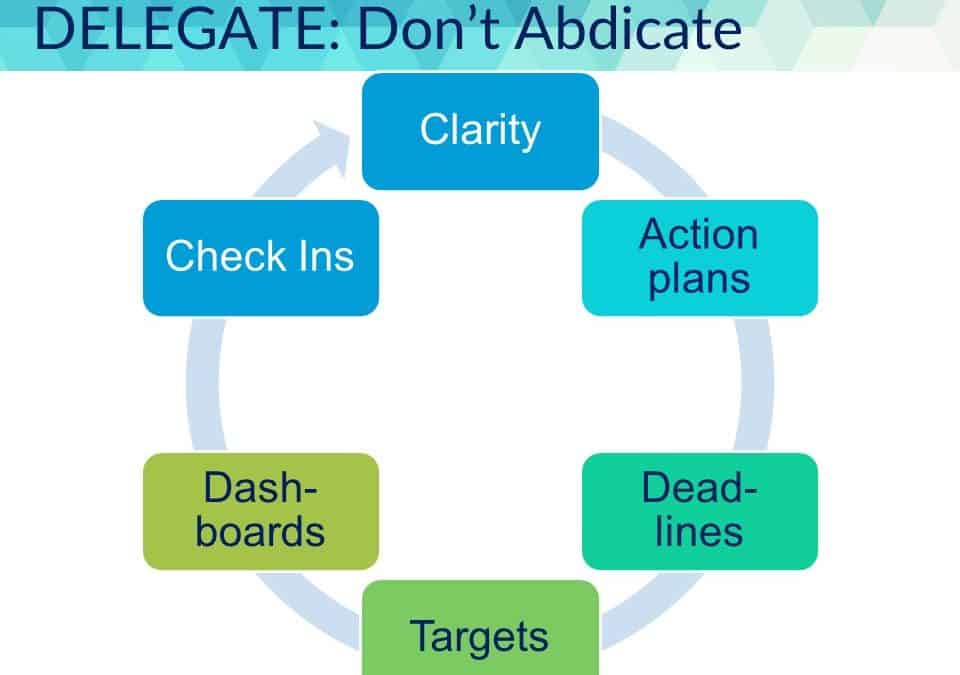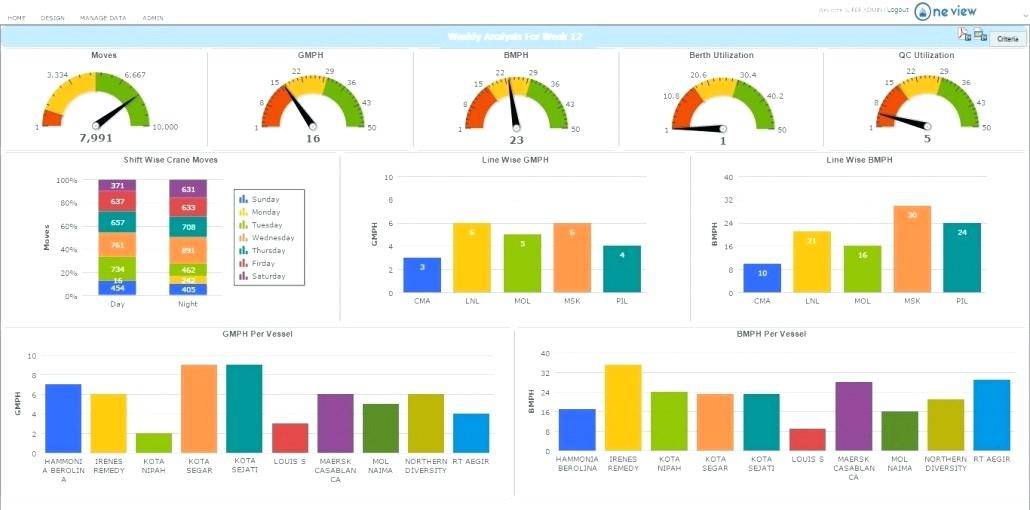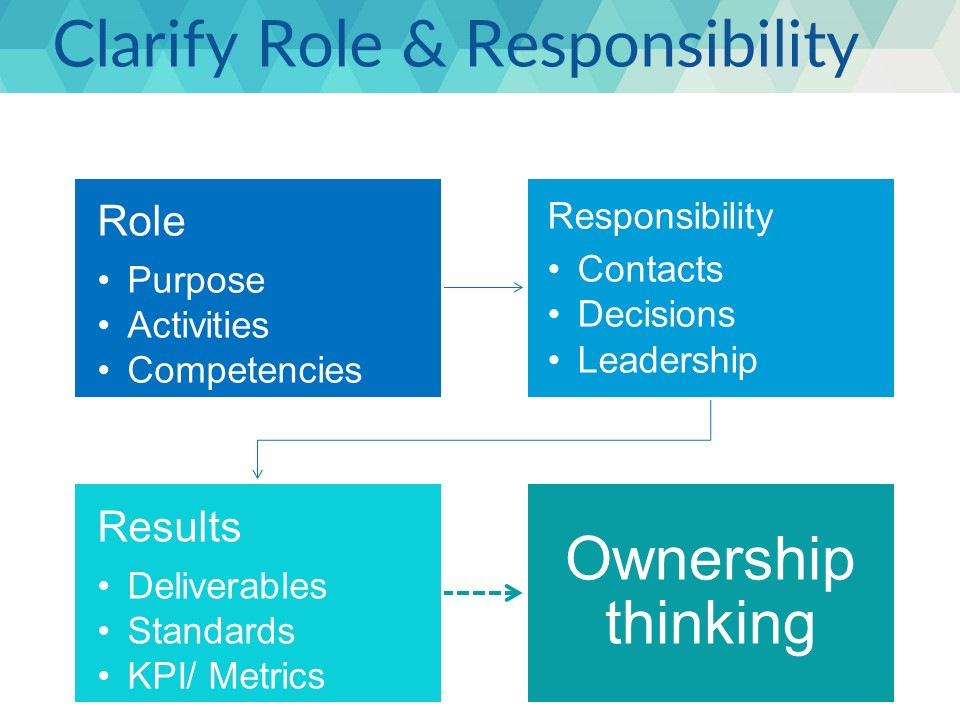
by Diana Southall | Apr 3, 2018 | accountability, Delegation
How often do you ask someone to do something and don’t follow up?
Kings and Queens don’t usually abdicate their throne but managers often do when they delegate a task…
This “delegation” process might sound familiar:
- You casually and quickly mention to someone “I need you to do this ‘thing’ for me.”
- You “hope” the person understands what to do, has the knowledge to do it, will squeeze this new non-urgent task into their busy week, and will make a decision equal to the one you would make.
- And you get busy.. (that’s why you delegated in the first place, to take something OFF your plate, and have one less thing for you to remember.)
- Maybe you remember once to ask “how is that going” only to be met with either panic or remorse or a promise “I will get to that this week.”
- Then time goes by, you forget to follow up, you get frustrated when you remember it.. another ball is dropped, another great idea is withering away.
You say to yourself “but I delegated it– why didn’t it get done? Why can’t Joe get things done?”
The short answer is you did not DELEGATE, you ABDICATED responsibility.
Continuing my 6-part series on coaching for accountability (you can Read Step 1, Step 2, Step 3 and Step 4 here) or see all 6 steps on my 1 minute video slideshare.
Step 5 to Coach for Accountability and High Performance: Create a True Delegation Process- 6 Steps

- Clarity: Give crystal clear instructions, including expected actions, responsibility, outcomes, and expected completion date
- Action plan: Verify that the delegatee adds this task or project to their weekly action plan/ status report [break down a larger project into the next 2-3 action items]
- Deadlines: Give the entire project a deadline– then back up major “milestones” [outcomes, phases] with expected completion time to arrive at key dates
- Targets: Identify a key metric related to successful progress of this project (such as percent completion or meeting milestones scheduled dates or actual versus estimated targets)
- Dashboard: For projects over 3 months or with multiple milestones, setup a visual dashboard to track progress and update priorities
- Check ins: Weekly individual meetings [and weekly status reports] are the ideal way to keep any delegated items/ projects top of mind and on track, as well as find out what rockblocks are preventing progress, so you can provide additional clarity/ information/ knowledge/ resources are needed to keep moving
If you have used all 6 of these steps when you delegate and you are still not seeing progress, then I suspect you have an issue with the Job Fit of the person.
If you haven’t used all 6 steps, then the lack of progress is partly your responsibility.
Remember as a manager, accountability works both ways!
You need to setup your team members for success, and give them the training, coaching and resources they need to make progress and good decisions.
Next article I will share details on Step 6 “Consistency – Every Week.” [see all 6]

by Diana Southall | Mar 26, 2018 | accountability, dashboards, planning
How do you know when to fill up the gas tank on your car?
Or when you are speeding above the speed limit? Or your engine is overheating? Or your tire pressure is too low?
Because … every car has a dashboard — a handy visual guide to the key things that matter to operate your vehicle properly. (Geeky history: They have been around since the early days of autos – the speedometer was invented in 1902 and installed in cars since about 1910. My great aunt Louise proudly told tales of driving her dad’s roadster over 100 miles per hour on country roads in the 1920’s.)
So if your $35,000 auto has a dashboard, do you have one for your multi-million dollar business?
Today I continue my 6-part series on coaching for accountability (you can Read Step 1, Step 2, Step 3 here) or see all 6 steps on my 1 minute video slideshare.
Step 4 to Coach for Accountability and High Performance: Develop a Dashboard with your key metrics:

What should you include on your dashboard?
I highly recommend using categories similar to the “Balanced Scorecard” approach.
This means that your dashboard shows key numbers to track and evaluate:
- continue with financial measures (sales, profit, cash)
- add operational metrics (leads, proposals win rate, on-time-delivery, quality)
- include “voice of the customer” (net promoter score or customer feedback)
- employee experience (retention, engagement scores)
You can see the advantages of this concept– if you are focused solely on current sales or cash in the bank, there are other other areas of your business that need tending for future success. If you don’t have leads or are losing work to your competitors, or your service delivery level or employee engagement is dropping, these are warning signs that predict lower revenue and profits.
8 Benefits of Dashboards
1. Visibility: The new field of “Business Intelligence” or BI shows that the more you measure in your business the more you can improve. What is measured becomes higher priority and gives you the tangible target to improve.
2. Maintain quality during growth: If your business is growing, you need to make sure that you are maintaining the quality and customer experience standards and your team is not burning out.
3. Alerts before systems break: When you track leading indicators, you can see issues coming before they happen. For example, if you track pending orders you might see that your current production schedule can’t handle the order volume and will be backlogged by two weeks. Dashboards can alert you to this before chaos ensues.
4. Less stress: When you have a dashboard, you can get timely and accurate data on your business health, compared to your targeted goals and to historical trends. This will allow owners and general managers to feel more comfortable letting go of responsibilities, while knowing they are “watching the store” and things are running smoothly.
5. Basis for accountability: How do you know your managers are doing their job? Easy, just check their department dashboards. Where do they need more coaching? — you will see a lack of improvement or a drop in their key numbers to let you know there is an area to discuss and determine the root cause. This ongoing process improvement conversation increases the business knowledge and the decision making competencies of your managers.
6. Data to make / evaluate decisions: Did that marketing campaign or new training program yield positive business results? If you see improvement in your dashboard numbers, you can see if a project was successful.
7. Creates ownership thinking and alignment: This is especially true when business dashboard metrics “cascade” down to departments and to individuals. Employees and managers start to understand what they can do to increase revenue and customer service and efficiency or reduce costs.
8. Improves revenue, productivity, margins, profits and teamwork. As you can see from the list above, focus and clarity around what is important to drive business value and improve your value to customers will only improve your financial results and operational capacity.
As you can see from this list, implementing dashboards and management review and planning around the data can be the foundation of high functioning, profitable and growing organization.
Next article I will share details on Step 5 “Delegate, Don’t Abdicate” [see all 6]

by Diana Southall | Mar 19, 2018 | accountability, action plans, coaching
This continues my 6 part series on coaching for accountability (you can read Step 1 and Step 2 here).
Step 3 is to start using Action Plans:
6 Steps to Coach For Accountability & High Performance [see all 6 steps on my 1 minute video slideshare].
Most employees (and also most managers) are naturally focused on getting their “day job” done. Their cognitive “time span” and time management skills are typically focused on the next day or next week.
This is a major reason that all your good ideas and wish list of projects for improvement never get very far, much less implemented.
The concept of an Individual Action Plan has personally been an incredible organizing and planning tool for my entire life, and changed the direction of our family business.
When I was in high school, our family business started using a business consultant, who taught every one of our 25 employees how to create and use a personal action plan.
My mother had 3 retail stores, two production facilities and a business services division with hundreds of accounts.
When every person had an action plan and they had “quarterly action plan meetings” they were able to focus on the daily work AND make progress on those pesky projects. It also made it easy to see how everyone was contributing and working together on business building activities.
It made the difference between chaos and progress, and transitioned us from overwhelm to a professionally managed profitable business.
There are two inter-related purposes for action plans-– the first is to monitor and prioritize activities that support major projects or programs. The second is to use action plans as a training and development tool. I say inter-related because when people contribute to projects this contributes to their skill and competency development.
Your employees want and need ongoing reminders and assistance with taking action on bigger projects, so that they make progress and focus on small steps every week.
When they have a written action plan, and they review in your weekly coaching conversations, this helps them stay on track. If you don’t review and hold them accountable to make progress, anything beyond daily urgent work gets forgotten.
Quarterly Action Plans Overview:
Ideally you need to do a bit of design and discovery to begin the action plan process.
- First you need to compile a full list of all active company-wide projects and create an action plan for each, with sections or tasks assigned to the responsible person. [More than 4 projects— prune the list down.]
- Second, you should meet with everyone individually to discuss their desired training and development direction [part of your annual performance conversation.]
- Both of these topics become action steps on an individual quarterly action plan.
What goes on an action plan?
- Specific training for the quarter- aligned with personal interest and business need
- Stretch assignments– areas where this person can enrich or enlarge their job duties beyond the current role
- Delegation items to take over responsibility from peer or manager
- Action items or steps from company-wide or department projects assigned to this person
- Cross-training to “back up” or shadow someone
- Research opportunities– what problem can they investigate possible solutions?
- Outside/ formal training programs or workshops, such as industry certification or a job-related degree
Action plans also need to list specific action items, aligned with a broader goal, who is responsible, and a target date for completion.
They are an integral part of aligning every team member’s work with the business goals, and to leverage the rhythm of weekly coaching with progress on business-improvement projects.
As an added bonus, you will be building trust and the engagement of your team by focusing on the key drivers of retention. With the right topics and agenda, the quarterly action plan meetings become “stay interviews”– a technique that employers are finding valuable to hold onto their high performers.
Next Steps:
Watch my 21-minute video training on Action Plans for Training & Development
Next step I will share details on Step 4 “Delegate, Don’t Abdicate” [see all 6], and expect to have a new Guide to Coaching for Accountability by the end of this month.

by Diana Southall | Mar 14, 2018 | accountability, coaching, performance
Read my last article on Step 1 to coach for accountability [clarify who does what].
Step 2 is to start Weekly Coaching Conversations:
6 Steps to Coach For Accountability & High Performance [see all 6 steps on my 1 minute video slideshare].
Your employees want and need ongoing direction & feedback & support & recognition, so that they can focus on high priority actions.
Just like a sailboat, if they drift just one degree off course every week they can end up going East instead of North.
You need them to tell you when they are stuck, if they need clarification or resources, and to make more informed decisions.
You also want them to make progress on projects beyond their daily tasks.
All of these employee and manager needs can be met with a 15-minute “weekly coaching conversation”
Weekly Coaching Conversation [Check Ins] Agenda:
- Results on individual/ team KPI [key performance indicators]
- Status update on ongoing tasks [what my manager needs to know]
- Status update on project action items
- Challenges- where are you stuck or need more help?
- Priorities for this week
….I know you are thinking “how am I going to squeeze in weekly chats with every one of my team?”
I will be honest, the first few weeks are hard for managers to schedule, but then they find something miraculous ….
After a few weeks– people start changing how they interact with their managers:
- They hold the “do you have a second” updates and questions for their weekly chat [time saved 5+ minutes per day x per person]
- You don’t have to chase people down to get status updates — you know you will hear them on your weekly chats [time saved 10 minutes x per person]
- They start completing project action items that you assigned but never went anywhere [1+ hours per week of new “to-dos” completed x per person]
- You now have a way to start handing off small action items on the bigger projects to someone else [time saved 1-2 hours week of your time]
- You don’t have to put out fires because someone forgot or were stuck or handled something badly [time saved 1+ hour per week]
When you think about all the time you spend on all these reactive activities, it adds up to well over 15 minutes per person.
Would it be better to have a pre-planned time carved out of your schedule to be proactive, to give direction, feedback, support, recognition, and coach for learning and improved decision making and time management?
If you have more than 10 people, over time you can designate and train a “team leader” to have these weekly conversations with the team and just bring you the weekly team updates [time saved 15 minutes x per person]. As an added benefit, this process develops your high potential employees into team leaders.
As with anything that is “good for you” it takes a bit of effort to change your habits and the habits of your team, and diligence to keep consistency and progress.
Managers who master this habit say they would never go back to their old ways.
Next Steps:
In my next article, I will share details on Step 3 “Action Plans for Development and Business Improvement” [see all 6].

by Diana Southall | Feb 27, 2018 | accountability, coaching, job role, performance
Are you interested in everyone on your team taking on more responsibility?
I mean real responsibility — when they “own” the work, solve issues, make suggestions and even improve the process, and [the ultimate level] keep you in the loop with status updates or “exception” reports.
You might even have a few people who do this now… but you would like EVERYONE on staff to do this. [Keep reading for the First of the 6 steps…]
This magical state is called the “Accountability Culture” — and blends the benefits of a Results Culture and a Caring Culture, and the top ranked most-effective leadership style that blends concern for People with a focus on Results.
Accountability is not a new concept, but it has become a high priority for the business owner and manager who wants to spend more time on business planning and management and less time on getting the daily work done.
If your team “does what they are supposed to do” then managers are freed up to work on the business- revenue generation, process improvement, cost control and great team and customer experiences. If your pants are on fire you can’t plan and improve your business.
Let me be clear—- Positive Accountability is essential to grow your business.
Last week I spoke to 91 planners and managers in operations, who work for companies with 50-500 employees. Guess what? These organizations are also challenged with building accountability on their teams.
Here is your opportunity to take your smaller more agile company and out-perform you competitors, with
6 Steps to Coach For Accountability & High Performance.
Step 1 is to clarify the Roles, Responsibilities and Results of your key people:

Employees want to have four main questions clarified about their role (although they rarely ask them):
If you cannot answer these questions about your role and those of your key people,
you will not be able to effectively hold them accountable for results.
1. What is my role?
2. What does “good” look like?
3. What is my responsibility?
4. What results should I produce?
To Learn More:
For a detailed outline of how to accomplish Step 1 [Clarify Roles and Responsibilities], see page 7.
See all 6 Steps to Coach for Accountability [Slideshow]











